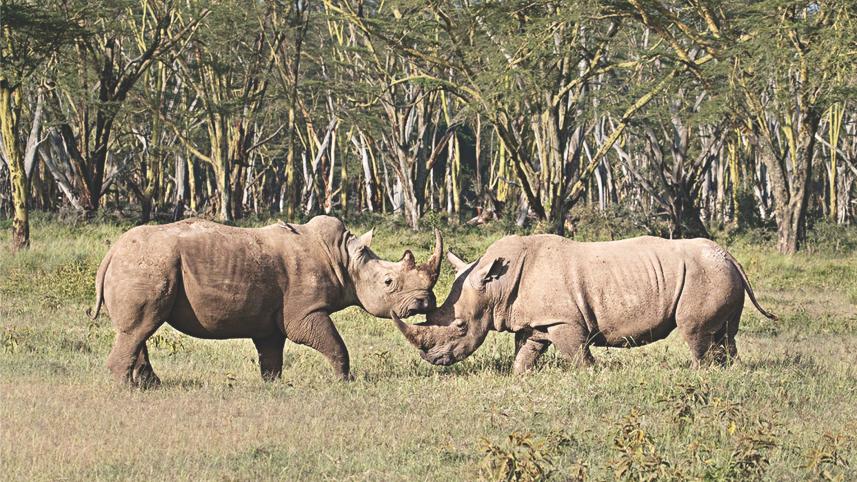Rhino

Last week I wrote about the book African Silences by Peter Matthiessen recounting a series of trips he made in Africa in search of birds and wildlife. Along with other animals, the book taught me about the White Rhino.
Among all land mammals in the world, the rhino is second only to the elephant in size. There are five species of rhinos in the world. They are White Rhino, Black Rhino, One-horned Rhino, Javan Rhino and Sumatran Rhino. The White Rhino is the largest, weighing in at around 6000 pounds. (In comparison, the African Elephant weighs up to 15000 pounds.) Rhinos are herbivores, living on grass and leaves. Although large, they are fast and can exceed 30 miles/hour during a charge. They are clad in a thick, protective skin up to 2 inches thick. Man is their only predator; they are killed for their horns used for medicinal purpose. Their name comes from their unique appearance: "Rhinoceros" is derived from a Greek word meaning "nose-horned."
Matthiessen observes that the White Rhino had two subspecies: Northern White Rhino and Southern White Rhino. The Northern subspecies has become extinct, largely due to wholesale slaughter by humans. For example, in the years following the assassination of Patrice Lumumba in the Congo, Simba rebels slaughtered 90% of the White Rhinos there for the purpose of selling their horns. The proceeds were used to buy more weapons. Subsequent efforts to save the subspecies came to naught.
The Southern White Rhino can be easily seen in South Africa.
The moniker "White" is a misnomer – the animals are not really white. It apparently comes from the word "weit", an Afrikaner word meaning "wide", called so because of their wide mouths. English settlers misheard the name.
The Black Rhino (not really black, but named as a counterpoint to the White Rhino!) is found in Kenya, South Africa, Namibia and Zimbabwe. I saw it in Kenya's Lake Nakuru National park which has the world's largest concentration of them: one hundred and fifty. In the early morning light two rhinos were grazing in a meadow. At one point they faced each other and nuzzled their large horns. It was touching to see the show of affection among these two giants.
The Javan Rhino is the rarest rhino, critically endangered, with around seventy-two left in the wild. They are the smallest of the rhinos but still formidable at 3000-5000 pounds. All surviving members live in Ujong Kulon National Park in Java.
The Sumatran Rhino is also critically endangered. It is estimated that less than a hundred live in the wild.
One rhino differs in appearance than all the others. While the rest have two horns, the Greater One Horned Rhino, living in India and Nepal, sports just one. Its story is in stark contrast to the Northern White Rhino. Once close to extinction, efforts to save it succeeded and today it numbers over three thousand, the majority in Kaziranga and Chitwan parks in India and Nepal respectively.
In Bangladesh, there are records of rhinos from the late 1880s and early 1900s. For example, Sundarban was home to a subspecies of the Javan Rhino. However, this subspecies, Rhinoceros sondaicus inermis, has become extinct. At other times Bangladesh also had the Greater One-horned Rhino and the Sumatran Rhino.
facebook.com/ikabirphotographs or follow ihtishamkabir on Instagram.



 For all latest news, follow The Daily Star's Google News channel.
For all latest news, follow The Daily Star's Google News channel.
Comments